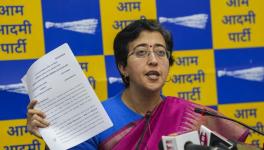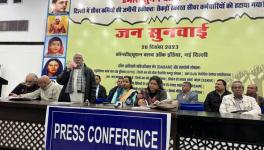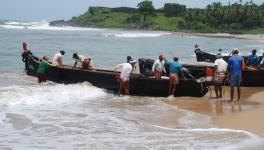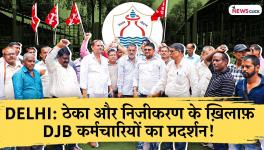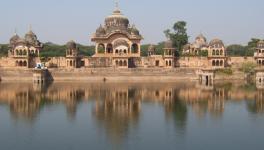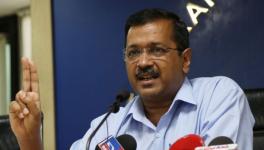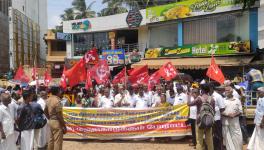Vikram Soni – Tribute to a True Environmentalist

Physicist and environmetalist Prof Vikram Soni. Image credit: Special arrangement
It was a battle between David and Goliath and sadly, in this case Goliath won. This allegory epitomises the life of Prof Vikram Soni, a brilliant physicist who had spent much of his life working in high energy physics and astrophysics but eventually moved into the field of public science and used science to find solutions to India’s increasing environmental problems.
The chronic water shortage that plagued our cities was one of the first problems Soni looked at. He was the first scientist to conduct extensive studies on the water potential of the floodplains of our rivers. He discovered, through a series of simple experiments, that the sandy aquifers on the floodplains of our rivers naturally stored and recharged a great deal of monsoon water that could provide a perennial, local and sustainable source of quality water for our cities.
Floodplains are exceptional aquifers, both wide and deep, storing a huge amount of water. They often carry about 20 times more water than the rivers themselves. Soni pointed out repeatedly that this precious resource built over millions of years should be used sparingly to ensure that cities end up using less water than is recharged every year by rainfall and by late-season floods.
Soni often said, “The floodplains must be used with great caution so that they are not over-exploited. The level of the aquifers in the flood plain had to remain higher than the river because otherwise the contaminated water of the river would flow into the aquifers and contaminate them.”
He never stopped over-emphasising that the flood plains were the only uncontaminated, unused source of fresh water we had since most of our rivers had become contaminated, as had large swathes of groundwater across our agricultural belts. Most of the state governments fail to understand the value of our flood plains. The result is that they are likely to be lost forever to reckless sand mining and endless construction.
Soni did his Ph.D from the University of California, Santa Barbara and after teaching at the University of Sussex, joined the Department of Theoretical Physics at the University of Madras and then went on the basis of his research, to become a UGC professor. He worked on several aspects of neutron stars and magnetors and there is an object called instanton in quantum field theory that has been called `Sonion' after his name.
Soni’s first round of research was confined to the Yamuna floodplains, but persuading the Delhi government and the Delhi Jal Board (DJB) to accept this point of view was not easy. He spent seven long years of voluntary service interacting with government babus and politicians, to make them understand that his schemes could go a long way in mitigating the water shortage Delhi was facing.
Finally, it was in 2009 that then Prime Minister Manmohan Singh’s secretariat agreed to a unique project to be executed in a 20-25 km stretch of the Yamuna floodplain and implemented by the DJB. It was the first such project in the world.
This stretch of the Yamuna floodplain, called the Palla floodplain, was located north of Wazirabad. After rigorous research, Soni found that this floodplain had a replenishable yield of between 80 -100 million cubic meters (MCM)/ year (50- 60 million gallons per day(MGD)). It had taken him close to a year to understand the hydrogeology of this floodplain and to make estimates for withdrawal of water. Setting up the project took another year.
In his words, “We established an ecological ‘Conserve and Use’ plan to augment this to its full potential of 100 MCM/year (60 MGD). At the median rate of domestic water charged by the Jal Board for the consumer, this would provide a revenue of about Rs 400 crore per year for the DJB”.
In 2014, the project was providing 25 MGD of drinking water for one million people and helped the DJB earn a profit of Rs 250 crore. But from the start there were teething problems. The DJB engineers were simply not interested in providing a low-cost solution to solve the city’s water problems. The pipelines drawing out the water were in a state of disrepair and no one was interested in getting them repaired or changed. As a result, it was unable to deliver 50 MGD of water, as had been originally intended, and was functioning at half capacity.
The fact on the ground was that although Soni had been appointed an honorary advisor to DJB and was meant to supervise the project, his work was simply not appreciated.
The change of government in 2014 worsened the situation. By 2016, the project got stalled with no one interested in pushing it. This did not stop the Delhi government from boasting in a public release in 2016 that the ‘Palla project was an original, ‘Conserve and Use’ ecological, non-invasive and perennial water project — the first such project in the world’ and that such floodplain projects could be used to provide water for over 500 river towns in India. The project received praise from the South Australian Water facility, among other bodies.
The investment on this project was around Rs 100 crore and its running cost was calculated at Rs 5 crore a year. Initially, Rs 13 crore was spent on the SCADA system, which monitored and regulated all hydrological parameters of the floodplain water but when a technical problem arose with the SCADA system, the DJB engineers were not interested in rectifying it. This lack of seriousness was heartbreaking for Soni and his team because if it had been properly executed, it would have proved a low-cost solution that could be replicated across all our riverine cities.
In South India around the same time, there was a great deal of excitement about how Andhra Pradesh Chief Minister Chandrababu Naidu was planning to construct a new capital on the banks of the Krishna river with the name of Amravati. In 2010, Soni visited this proposed site and pointed out that “Amaravati’s floodplains, if not concretised by needless construction, could generate water for a million residents. The economic value of that water would be around Rs900 crore per year, which the city could have got for free.”
He prepared a detailed plan on the water use of the Krishna flood plains but Naidu’s government had other ideas. They wanted to maximise land usage by building a line of offices and buildings on this floodplain. Soni offered the state government an alternative vision on how Amravati could be built as a self-sustaining capital city, for which he used the nomenclature of `Natural City’, but sadly, Naidu was not interested in either of these schemes.
The Natural City plan did find some prominent backers. M.S.Swaminathan, who played a leading role in India’s Green Revolution, wrote to Naidu stressing the importance of incorporating several aspects of this (natural) city plan since these “will be in consonance with the UN Sustainable Development Goals”. But there was no response from Naidu’s government and instead, Amaravati was piloted by experts from Singapore, Japan and a London-based architecture firm.
India has a long history of its cities being moulded by foreign minds, starting with Le Corbusier’s master plan for Chandigarh.
“It’s about time we came up with some ideas of our own,” Soni said. “We need to understand how we live and how we can do it better. We need to start learning to solve our problems ourselves. Cities could change the way we live our lives. The city could be an extremely pleasant place.”
There was another drinking water project that was close to Soni’s heart and that was to provide ‘real and local mineral water’ to the citizens. He believed, as do most doctors, that RO water causes several health problems since this water is de-mineralised and acidic.
Soni’s studies had shown that cities like Delhi, Udaipur, Alwar could receive large portions of their drinking water needs from local forested hills – the Aravalli hills. Cities in Tamil Nadu, such as Vellore, Madurai, Coimbatore and Kanyakumari, could get mineral water from the Western Ghats. Mumbai could get this water from Borivali National Park while Bangalore could get it from Bannerghatta. In fact, hundreds of other cities in India and abroad can get subterranean mineral water from locally forested hills or compressed forests.
This would be a huge boon for the health of the citizens and generate a large revenue for the government – even if the water was being sold at a very affordable price like Rs 2 per litre.
The whole impetus of Soni’s unique work was to find simple, doable and inexpensive solutions to the key issues the public were facing. Equally important, using water from the hills and forests would be an impetus to protect them. If these forests were given an elevated status of mineral water sanctuaries, that would ensure the state governments also play a role in conservation. Here again, the principle of ‘conserve and use’ had to be strictly applied because recharge of these water sources was necessary to ensure they do not dry up.
Could these projects have helped mitigate the water crisis in South India, had they been implemented there?
Local mineral water could be provided to several cities from the Eastern and the Western Ghats. South India’s rivers have large prominent floodplains. Our study shows that this scheme could be used to provide bulk water to several cities. Water cannot be taken from agricultural land because it is polluted and has been found to have high levels of toxicity.
But again, Soni’s problem was that no state government was willing to execute this project. This again was a matter of great disappointment for him. But he stood his guns and insisted all through his life that natural resources and sources of water – mountains, lakes, rivers, floodplains, forests, hills must be declared as inviolate. A huge penalty should be charged for destruction of these resources.
In the world of science, Soni made seminal contributions to the understanding of phenomena ranging from the nucleon to neutron stars and from the matter-antimatter puzzle to evolutionary networks. Having grown up with a forester as a father, he had spent his childhood exploring the dense, pristine forests of India.
While working in the field of physics, he could not overlook the manner in which successive governments were party to the axing of vast swathes of forest at a time when we were already facing a nation-wide shortage of water. It was this commitment to nature that had him play a pivotal role in preserving 690 acres of the Aravalli Biodiversity Park in Vasant Vihar in New Delhi.
During the past few years of his life, Soni did not stop repeating that fresh water was getting scarcer by the year. The erstwhile Planning Commission’s ex-member Mihir Shah had warned that by 2030 we would only have half the water that we required. The only way water levels could be improved was to augment our water sources and this could be done by planting more forests. All rivers and their floodplains, streams and lakes, must be forested along their boundaries for at least half a kilometre on all sides and declared as water sanctuaries.
Soni was also an advocate of the immediate need for the agricultural map to be redrawn so that half the country that is water short, adopts more efficient water practices, such as drip irrigation and changes to less water intensive crops.
Soni’s book, Naturally: Tread Softly on the Planet, voices the concerns that he fought for all his life. It eloquently articulates a living scheme based on the way nature works without any waste. He examined the ecological viability of various energy sources, ranging from solar to nuclear and the waste they generate. He believed that all human interventions must look for enlightened solutions that are not injurious to Gaia, Mother Earth. The book also included several examples of wisdom that work in harmony with the natural order of the planet.
He was a pioneer and worked in an understated manner with no political backing. The result was all these life transforming schemes, simple but profound, went over the heads of bureaucrats who are used to pushing non-functional projects that cost thousands of crores. In fact, a Delhi-based bureaucrat once told him that a Rs 100-crore proposal was no proposal as far as he was concerned! This lack of interest in his work left him frustrated and could also have been one of the reasons that triggered the onset of ALS, a motor neuron disease, that resulted in his death on June 11 2025.
It is one of the many tragedies of our time that the ideas of a visionary scientist, dedicated to bettering life on planet earth, went largely ignored during his lifetime. One hopes that someday, before it is too late, wisdom dawns on our netas and babus and they explore such ideas instead of recklessly destroying the environment that sustains us all.
The writer is an independent journalist. The views are personal.
Get the latest reports & analysis with people's perspective on Protests, movements & deep analytical videos, discussions of the current affairs in your Telegram app. Subscribe to NewsClick's Telegram channel & get Real-Time updates on stories, as they get published on our website.









